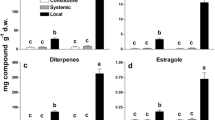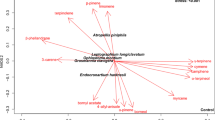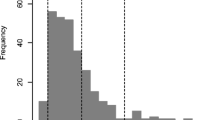Abstract
Conifers possess a suite of physiochemical defenses that protect their subcortical tissues from bark beetle - fungal complexes. These defenses include rapid induction of terpenoids and phenolics at the site of attack. Studies of the distribution, induction, and bioactivity of conifer terpenoids have focused heavily on monoterpenes. We assessed induction of diterpene acids in white spruce (Picea glauca) and red pine (Pinus resinosa) to fungal associates of two bark beetles, and the responses of four spruce beetle (Dendroctonus rufipennis)—associated fungi to three diterpene acids. Constitutive phloem contents differed between species, in that red pine had extremely low concentrations of diterpene acids, whereas white spruce had substantial constitutive levels. Induction differed quantitatively. Both red pine and white spruce exhibited marked increases, but red pine underwent greater increases and achieved higher concentrations than white spruce. Induction also differed qualitatively in that red pine showed lower diversity and fewer compositional changes during induction than white spruce. In red pine,fungal inoculation accompanying wounding elicited greater increases than wounding alone, but in white spruce total concentrations were higher following wounding alone. Spruce beetle fungal symbiont growth varied among species and compounds. Some diterpenes elicited both stimulatory and inhibitory effects on fungi, depending on concentration. All four fungi exhibited higher tolerances compared to those associated with pine bark beetles in previous studies. Variation in tolerances to, and potentially metabolism of, diterpene acids by symbionts may reflect differences in constitutive levels between spruce and pine, and partially explain differences in concentrations achieved during induction.


Similar content being viewed by others
References
Adams AS, Boone CK, Bohlmann J, Raffa KF (2011) Responses of bark beetle-associated bacteria to host monoterpenes and their relationship to insect life histories. J Chem Ecol 37:808–817
Aukema BH, Werner RA, Haberkern KE, Illman BL, Clayton MK, And Raffa KF (2005) Quantifying sources of variation in the frequency of fungi associated with spruce beetles: implications for hypothesis testing and sampling methodology in bark beetle—symbiont relationships. For Ecol Manag 217:187–202
Bates D, Maechler M, Bolker B, Walker S (2014) Lme4: linear mixed-effects models using eigen and S4. R Package Version 1.0–6. Available At http://Cran.R-Project.Org/Package=Lme4
Bentz BJ, Six DL (2006) Ergosterol content of fungi associated with dendroctonus ponderosae and Dendroctonus Rufipennis (Coleoptera: Curculionidae, Scolytinae). Ann Entomol Soc Am 99:189–194
Bleiker AKP, Six DL (2007) Dietary benefits of fungal associates to an eruptive herbivore: potential implications of mulitple associates on host population dynamics. Environ Entomol 36:1384–1396
Blomquist GJ, Figueroa-Teran R, Aw M, Song M, Gorzalski A, Abbott NL, Chang E, Tittiger C (2010) Pheromone production in bark beetles. Insect Biochem Mol Biol 40:699–712
Bohlmann J (2012) Pine terpenoid defences in the mountain pine beetle epidemic and in other conifer pest interactions: specialized enemies are eating holes into a diverse, dynamic and durable defence system. Tree Physiol 32:943–945
Boone CK, Aukema BH, Bohlmann J, Carroll AL, Raffa KF (2011) Efficacy of tree defense physiology varies with bark beetle population density: a basis for positive feedback in eruptive species can. J For Res 41:1174–1188
Boone CK, Keefover-Ring K, Mapes AC, Adams AS, Bohlmann J, Raffa KF (2013) Bacteria associated with a tree-killing insect reduce concentrations of plant defense compounds. J Chem Ecol 39:1003–1006
Brignolas F, Lieutier F, Sauvard D, Christiansen E, Berryman AA (1998) Phenolic predictors for norway spruce resistance to the bark beetle Ips Typographus (Coleoptera: Scolytidae) and an associated fungus, Ceratocystis Polonica. Can J For Res 28:720–728
Carroll AL, Régnière J, Logan JA (2006) Impacts of climate change on range expansion by the mountain pine beetle. E. mountain pine beetle initiative working paper 2006–14. Canadian Forest Service, Ottawa
Clark EL, Pitt C, Carroll AL, Lindgren BS, Huber DPW (2014) Comparison of lodgepole and jack pine resin chemistry: implications for range expansion by the mountain pine beetle, Dendroctonus Ponderosae (Coleoptera: Curculionidae). Peerj 2:E240
R Core Team (2013) R: A language and environment for statistical computing. Vienna, Austria
Davis TS, Hofstetter RW (2011) Reciprocal interactions between the bark beetle-associated yeast Ogataea Pini and host plant phytochemistry. Mycologia 103:1201–1207
De Mendiburu F (2014) Agricolae: statistical procedures for agricultural research. R Package Version 1.2-0. Available At http://Cran.R-Project.Org/Package=Agricolae
Elkinton JS, Wood DL, Browne LE (1981) Feeding and boring behavior of the bark beetle, ips paraconfusus, in extracts of ponderosa pine phloem. J Chem Ecol 7:209–220
Erbilgin N, Krokene P, Christiansen E, Zeneli G, Gershenzon J (2006) Exogenous application of methyl jasmonate elicits defenses in norway spruce (Picea Abies) and reduces host colonization by the bark beetle ips typographus. Oecologia 148:426–436
Everaerts C, Grégoire J-C, Merlin J (1988) The toxicity of norway spruce monoterpenes to two bark beetle species and their associates. In: W. Mattson, J. Levieux, and C. Bernard-Dagan (eds.). Mechanisms of woody plant defenses against insects Se - 23. Springer New York, 335–344
Faccoli M, And Schlyter F (2007) Conifer phenolic resistance markers are bark beetle antifeedant semiochemicals. Agric For Entomol 9:237–245
Franceschi VR, Krokene P, Christiansen E, Krekling T (2005) Anatomical and chemical defenses of conifer bark against bark beetles and other pests. New Phytol 167:353–375
Haberkern KE, Illman BL, Raffa KF (2002) Bark beetles and fungal associates colonizing white spruce in the great lakes region. Can J For Res 32:1137–1150
Hall DE, Zerbe P, Jancsik S, Quesada AL, Dullat H, Madilao LL, Yuen M, Bohlmann J (2013) Evolution of conifer diterpene synthases: diterpene resin acid biosynthesis in lodgepole pine and jack pine involves monofunctional and bifunctional diterpene synthases. Plant Physiol 161:600–616
Hamberger B, Ohnishi T, Hamberger B, Séguin A, Bohlmann J (2011) Evolution of diterpene metabolism: sitka spruce cyp720b4 catalyzes multiple oxidations in resin acid biosynthesis of conifer defense against insects. Plant Physiol 157:1677–1695
Hammerbacher A, Ralph SG, Bohlmann J, Fenning TM, Gershenzon J, Schmidt A (2011) Biosynthesis of the major tetrahydroxystilbenes in spruce, astringin and isorhapontin, proceeds via resveratrol and is enhanced by fungal infection. Plant Physiol 157:876–890
Hammerbacher A, Schmidt A, Wadke N, Wright LP, Schenider B, Bohlmann J, Brand WA, Fenning TM, Gershenzon J, Paetz C (2013) A common fungal associate of the spruce bark beetle metabolizes the stilbene defenses of norway spruce. Plant Physiol 162:1324–1336
Hothorn T, Bretz F, Westfall P, Heiberger R, Schuetzenmeister A (2014) Package “Multcomp .” R Package Version 1.3–7. Available At http://Cran.R-Project.Org/Package=Multcomp
Huber DPW, Ralph S, Bohlmann J (2004) Genomic hardwiring and phenotypic plasticity of terpenoid-based defenses in conifers. J Chem Ecol 30:2399–2418
Kane JM, And Kolb TE (2010) Importance of resin ducts in reducing ponderosa pine mortality from bark beetle attack. Oecologia 164:601–609
Keeling CI, Bohlmann J (2006) Genes, enzymes and chemicals of terpenoid diversity in the constitutive and induced defence of conifers against insects and pathogens. New Phytol 170:657–675
Kersten PJ, Kopper BJ, Raffa KF, Illman BL (2006) Rapid analysis of abietanes in conifers. J Chem Ecol 32:2679–2685
Kim J-J, Plattner A, Lim YW, Breuil C (2008) Comparison of two methods to assess the virulence of the mountain pine beetle associate, Grosmannia Clavigera, to Pinus Contorta. Scand J For Res 23:98–104
Klepzig KD, Raffa KF, Smalley EB (1991) Association of an insect-fungal complex with red pine decline in Wisconsin. For Sci 37:1119–1139
Klepzig KD, Kruger E, Smalley EB, Raffa KF (1995) Effects of biotic and abiotic stress on induced accumulation of terpenes and phenolics in red pines inoculated with bark beetle-vectored fungus. J Chem Ecol 21:601–626
Klepzig KD, Smalley EB, Raffa KF (1996) Combined chemical defenses against an insect-fungal complex. J Chem Ecol 22:1367–1388
Kopper BJ, Illman BL, Kersten PJ, Klepzig KD (2005) Effects of diterpene acids on components of a conifer bark beetle—fungal interaction: tolerance by Ips Pini and sensitivity by its associate Ophiostoma Ips. Environ Entomol :486–493
Kusumoto N, Ashitani T, Murayama T, Ogiyama K, And Takahashi K (2010) Antifungal abietane-type diterpenes from the cones of Taxodium Distichum rich. J Chem Ecol 36:1381–1386
Larsson S, Ekbom B, Björkman C (2000) Influence of plant quality on pine sawfly population dynamics. Oikos 89:440–450
Lewinsohn E, Gijzen M, Muzika RM, Barton K, Croteau R (1993) Oleoresinosis in grand fir (Abies Grandis) saplings and mature trees. Plant Physiol 101:1021–1028
Lieutier F, Vouland G, Pettinetti M, Garcia J, Romary P, And Yart A (1992) Defence reactions of norway spruce (Picea Abies Karst.) to artificial insertion of Dendroctonus Micans Kug. (Col., Scolytidae). J Appl Entomol 114:174–186
Lieutier F, Yart A, Salle A (2009) Stimulation of tree defenses by ophiostomatoid fungi can explain attack success of bark beetles on conifers. Ann For Sci 66:801
Manning CG, Reid ML (2013) Sub-lethal effects of monoterpenes on reproduction by mountain pine beetles. Agric For Entomol 15:262–271
Mason CJ, Couture JJ, Raffa KF (2014) Plant-associated bacteria degrade defense chemicals and reduce their adverse effects on an insect defoliator. Oecologia 175:901–910
Miller AW, Kohl KD, Dearing MD (2014) The gastrointestinal tract of the white-throated woodrat (Neotoma Albigula) harbors distinct consortia of oxalate-degrading bacteria. Appl Environ Microbiol 80:1595–1601
Powell JS, Raffa KF (1999) Effects of selected Larix Laricina terpenoids on Lymantria Dispar (Lepidoptera: Lymantriidae) development and behavior. Environ Entomol 28:148–154
Raffa KF, Smalley EB (1988) Response of red and jack pines to inoculations with microbial associates of the pine engraver, Ips Pini (Coleoptera: Scolytidae). Can J For Res 18:581–586
Raffa KF, Smalley EB (1995) Interaction of pre-attack and induced monoterpene concentrations in host conifer defense against bark beetle-fungal complexes. Oecologia 102:285–295
Raffa KF, Aukema BH, Erbilgin N, Klepzig KD, Wallin KF (2005) Interactions among conifer terpenoids and bark beetles across mulitple levels of scale: An attempt to understand links between population patterns and physiological processes. In: T. R. John (ed.). Recent advances in phytochemistry. Elsevier, 79–118
Reynolds KM (1992) Relations between activity of dendroctonus rufipennis kirby on lutz spruce and blue stain associated with Leptographium Abietinum (Peck) Wingfield. For Ecol Manag 47:71–86
Rosner S, Hannrup B (2004) Resin canal traits relevant for constitutive resistance of norway spruce against bark beetles: environmental and genetic variability. For Ecol Manag 200:77–87
Schmelz EA, Kaplan F, Huffaker A, Dafoe NJ, Vaughan MM, Ni X, Rocca JR, Alborn HT, Teal PE (2011) Identity, regulation, and activity of inducible diterpenoid phytoalexins in maize. Proc Natl Acad Sci U S A 108:5455–5460
Seybold S, Huber DW, Lee J, Graves A, Bohlmann J (2006) Pine monoterpenes and pine bark beetles: a marriage of convenience for defense and chemical communication. Phytochem Rev 5:143–178
Smith JM, Hart SJ, Chapman TB, Veblen TT, Schoennagel T (2012) Dendroecological reconstruction of 1980s mountain pine beetle outbreak in lodgepole pine forests in Northwestern Colorado. Ecoscience 19:113–126
Tomlin ES, Borden JH, Pierce HD (1996) Relationship between cortical resin acids and resistance of sitka spruce to the white pine weevil. Can J Bot 606:599–606
Trapp S, Croteau R (2001) Defensive resin biosynthesis in conifers. Annu Rev Plant Physiol 52:689–724
Villari C, Battisti A, Chakraborty S, Michelozzi M, Bonello P, Faccoli M (2012) Nutritional and pathogenic fungi associated with the pine engraver beetle trigger comparable defenses in scots pine. Tree Physiol 32:867–879
Wagner M, Benjamin D, Clancy K, Schuh B (1983) Influence of diterpene resin acids on feeding and growth of larch sawfly, Pristiphora Erichsonii (Hartig). J Chem Ecol 9:119–128
Wallin KF, Raffa KF (2000) Influences of external chemical cues and internal physiological parameters on the multiple steps of post-landing host selection behavior of Ips Pini (Coleoptera: Scolytidae). Environ Entomol 29:442–453
Werner RA, Illman BL (1994) Response of lutz, sitka, and white spruce to attack by Dendroctonus Rufipennis (Coleoptera: Scolytidae) and blue stain fungi. Environ Entomol :472–478
Zhao T, Krokene P, Björklund N, Långström B, Solheim H, Christiansen E, Borg-Karlson A-K (2010) The influence of ceratocystis polonica inoculation and methyl jasmonate application on terpene chemistry of Norway spruce, Picea Abies. Phytochemistry 71:1332–1341, Elsevier Ltd
Zhao T, Krokene P, Hu J, Christiansen E, Björklund N, Långström B, Solheim H, Borg-Karlson A-K (2011) Induced terpene accumulation in norway spruce inhibits bark beetle colonization in a dose-dependent manner. Plos ONE 6:E26649
Zulak KG, Bohlmann J (2010) Terpenoid biosynthesis and specialized vascular cells of conifer defense. J Integr Plant Biol 52:86–97
Acknowledgments
This work was funded by McEntire Stennis WIS01430 and the University of Wisconsin-Madison College of Agricultural and Life Sciences. Critical reviews by two anonymous reviewers helped improve this paper.
Author information
Authors and Affiliations
Corresponding author
Rights and permissions
About this article
Cite this article
Mason, C.J., Klepzig, K.D., Kopper, B.J. et al. Contrasting Patterns of Diterpene Acid Induction by Red Pine and White Spruce to Simulated Bark Beetle Attack, and Interspecific Differences in Sensitivity Among Fungal Associates. J Chem Ecol 41, 524–532 (2015). https://doi.org/10.1007/s10886-015-0588-4
Received:
Revised:
Accepted:
Published:
Issue Date:
DOI: https://doi.org/10.1007/s10886-015-0588-4




